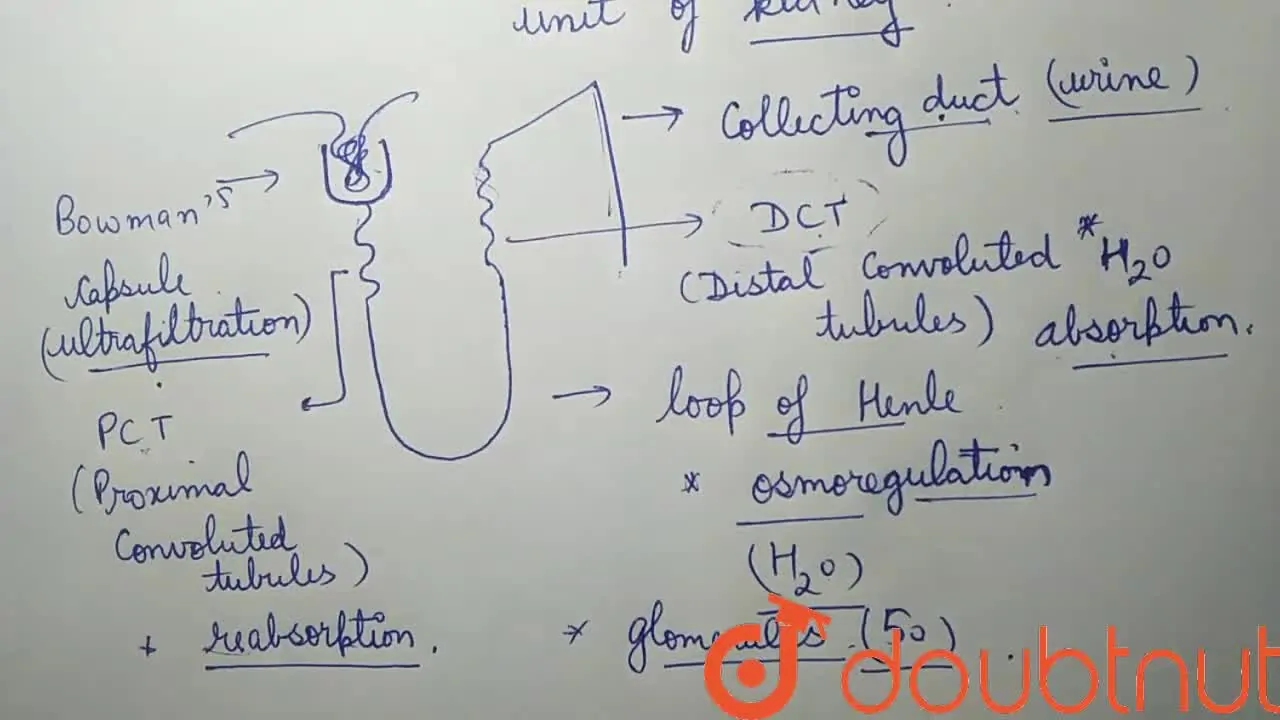Describe the structure and functioning of nephron.
Structure of a Nephron
A nephron is made up of (i) a globular double walled Bowman.s capsule around a clump of capillaries or glomerulus, and (ii) a tubule surrounded by blood capillaries. The tubule consists of (a) a proximal convoluted portion, (b) the loop of Henle, with descending and ascending limbs, and (e) a distal convoluted part.
The nephron empties into a collecting duct. The two million nephrons of a human being, end to end would extend for nearly 80 km. All the collecting ducts discharge into a central cavity of the kidney (pelvis) that connects to the ureter.
Functioning of Nephron
Urine is formed by 3 processes : glomerular filtration, tubular reabsorption and tubular secretion in the nephrons of kidney.
1. Ultrafiltration (Glomerular filtration) Blood is filtered under pressure in the glomeruli present in the cup like structure of Bowman.s capsule. Glomerular (nephric) filtrate is formed.
2. Tubular reabsorption In the PCT, entire glucose, amino acids, vitamins and hormones, most of the inorganic ions are reabsorbed by active transport, most of water by osmosis, and some urea by back diffusion from nephric filtrate. Loop of Henle mainly concentrates urine to conserve water. Here, some inorganic ions are actively taken up and some water leaves by osmosis.
3. Tubular secretion In the DCT, collecting tubule and collecting duct, many ions, water (depending upon availability) are secreted in to DCT and collecting duct.
Urine formed passes into bladder from kidney through ureters.
Related Playlists
- BOOK - MBD -HARYANA BOARDCHAPTER - LIFE PROCESSESEXERCISE - SHORT ANSWER TYPE QUESTION25videos
LIFE PROCESSES
- BOOK - MBD -HARYANA BOARDCHAPTER - LIFE PRCOCESS (NUTRIENT, RESPIRATION, TRANSPIRATION AND EXCERTIONEXERCISE - EXAMPLE183videos
LIFE PRCOCESS (NUTRIENT, RESPIRATION, TRANSPIRATION AND EXCERTION
- BOOK - MBD -HARYANA BOARDCHAPTER - MANAGKHOENT OF NATURAL RESOURCESEXERCISE - EXAMPLE117videos
MANAGKHOENT OF NATURAL RESOURCES
Similar Questions
Describe the structure and function of a nephron.
View SolutionDescribe the structure and function of ATP.
View Solution(a) Write the functions of the following parts in human female reproductive system:
(i) Ovary (ii) Oviduct (iii) Uterus
(b) Describe the structure and function of placenta.View Solution(a) Write the functions of the following parts in human female reproductive system:
(i) Ovary (ii) Oviduct (iii) Uterus
(b) Describe the structure and function of placenta.View SolutionDescribe the structure and functions of nucleus.
View SolutionDescribe the structure and functions of nucleus.
View SolutionDescribe the structure and function of pancreas.
View Solution(a) Write the functions of the following parts in human female reproductive system:
(i) Ovary
(ii) Fallopian tube
(iii) Uterus
(b) Describe the structure and functions of placenta.View SolutionDescribe the structure and functions of epithelium.
View SolutionDescribe the structures and function of androecium and gynoecium
View Solution


